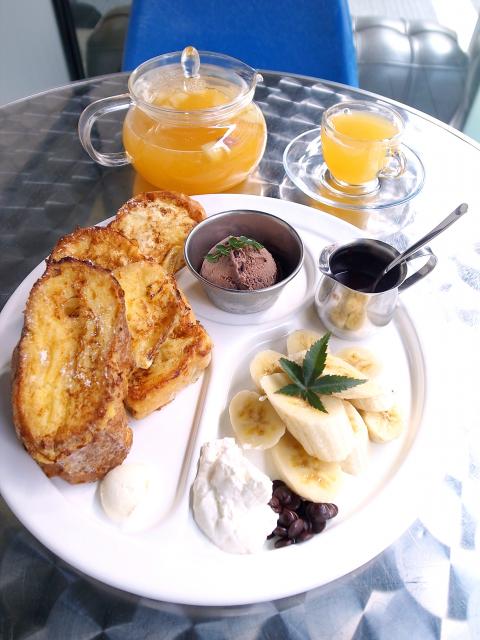Admittedly, a sleek cafe serving decorative waffles and sundaes in Taipei usually conjures up the image of snap-happy female customers in cutesy outfits. But those who feel acutely alienated from the kawaii mentality should have no difficulty dining at Wednesday Cafe. While frilly confections make up the bulk of its dessert menu, the establishment attracts a different demography with display cases filled with collectible toys and figures along with its reputation as a work of Wonderwall, a Japanese interior design firm founded by celebrated designer Masamichi Katayama and responsible for such creations as the BAPE, Uniqlo and Dean and Deluca stores in Japan.
Located on the boutique store-lined Daan Road (大安路), the cafe is hard to miss, greeting passersby with its fashionably promising, black-and-white storefront. Step inside and one is immediately lured by an array of toys, accessories and gismos for sale, including a necklace made of the head of a Barbie Doll.
The attraction continues in the spacious dining area, strewn with toy collectibles. Fans of Star Wars, The Simpsons, Batman and other American superheroes are likely to salivate at the extensive collection on display. In the back of the room, a pinball machine stands next to a DJ booth surrounded by more collectibles. Nearby, impeccably attired young chefs are seen minding the kitchen which is separated from the diners by large, spotless glass window.

Photos: Ho Yi, Taipei Times
The interior design, however, is rather disappointingly kept understated as if the purpose of the design is to direct all the attention to the cafe’s prized collection, composed of not only Americana toys but the timeless fiberglass chairs created by the legendary American designer couple Charles and Ray Eames in the 1950s. Consequently, it is not surprising that at the cafe, well-informed clienteles always choose chair seats over the lounge area.
Classics aside, Wednesday Cafe’s menu mostly belongs to the fusion genre. The savory options, in particular, show influences from the East and West. One example is the pan-fried short rib steak with truffle risotto (和風牛小排松露燉飯, NT$490). Mixed with mushrooms, asparagus and baby corns, the risotto comes with a small bowl of steamed white radish and a separate plate of thin-sliced steaks that were slightly overcooked.
For a local zest, Wednesday fried rice (Wednesday炒飯, NT$350) puts together a nostalgic flavor using lard, shallots and soy sauce. Chicken and bacon roll with sesame sauce (和風培根雞肉捲, NT$250) is a nicely balanced dish thanks to the sweetness of raisins and the aromatic sesame.

Photos: Ho Yi, Taipei Times
On the dessert section, the majority of the items involve either waffles or French toasts. The banana chocolate French toast (香蕉巧克力法式吐司, NT$250) I ordered is more than enough for two people and boasts chocolate ice cream, whipped cream, banana slices, butter and satisfyingly rich chocolate sauce. Other sweet choices include fruit sundae (水果聖代, NT$230), banana ice cream cake (冰淇淋芭娜娜, NT$180), blueberry waffle (藍莓鬆餅, NT$220) and earl grey tea-flavored pudding (布丁, NT$120).
The beverage menu sports an admirable selection of coffee and tea served either hot or cold including the Wednesday fruit tea (星期三水果茶, NT$220), hazelnut-flavored latte (榛果拿鐵, NT$195) and white gourd milk tea (冬瓜奶茶, NT$200). There is also a variety of milk shake (NT$220), smoothies (NT$220) and fruit milk (NT$220) to choose from. Health-conscious diners might want to check out the cafe’s special offering of fruit and vegetable juices (NT$240).
Wednesday Cafe also has a small patio seating area, which is not an entirely bad idea when the traffic is relatively slow on Daan Road. Service by the young waiting staff is adequate but offers no surprise.

This month the government ordered a one-year block of Xiaohongshu (小紅書) or Rednote, a Chinese social media platform with more than 3 million users in Taiwan. The government pointed to widespread fraud activity on the platform, along with cybersecurity failures. Officials said that they had reached out to the company and asked it to change. However, they received no response. The pro-China parties, the Chinese Nationalist Party (KMT) and Taiwan People’s Party (TPP), immediately swung into action, denouncing the ban as an attack on free speech. This “free speech” claim was then echoed by the People’s Republic of China (PRC),

Exceptions to the rule are sometimes revealing. For a brief few years, there was an emerging ideological split between the Democratic Progressive Party (DPP) and Chinese Nationalist Party (KMT) that appeared to be pushing the DPP in a direction that would be considered more liberal, and the KMT more conservative. In the previous column, “The KMT-DPP’s bureaucrat-led developmental state” (Dec. 11, page 12), we examined how Taiwan’s democratic system developed, and how both the two main parties largely accepted a similar consensus on how Taiwan should be run domestically and did not split along the left-right lines more familiar in

Many people in Taiwan first learned about universal basic income (UBI) — the idea that the government should provide regular, no-strings-attached payments to each citizen — in 2019. While seeking the Democratic nomination for the 2020 US presidential election, Andrew Yang, a politician of Taiwanese descent, said that, if elected, he’d institute a UBI of US$1,000 per month to “get the economic boot off of people’s throats, allowing them to lift their heads up, breathe, and get excited for the future.” His campaign petered out, but the concept of UBI hasn’t gone away. Throughout the industrialized world, there are fears that

The Democratic Progressive Party (DPP) controlled Executive Yuan (often called the Cabinet) finally fired back at the opposition-controlled Legislative Yuan in their ongoing struggle for control. The opposition Chinese Nationalist Party (KMT) and Taiwan People’s Party (TPP) acted surprised and outraged, but they should have seen it coming. Taiwan is now in a full-blown constitutional crisis. There are still peaceful ways out of this conflict, but with the KMT and TPP leadership in the hands of hardliners and the DPP having lost all patience, there is an alarming chance things could spiral out of control, threatening Taiwan’s democracy. This is no